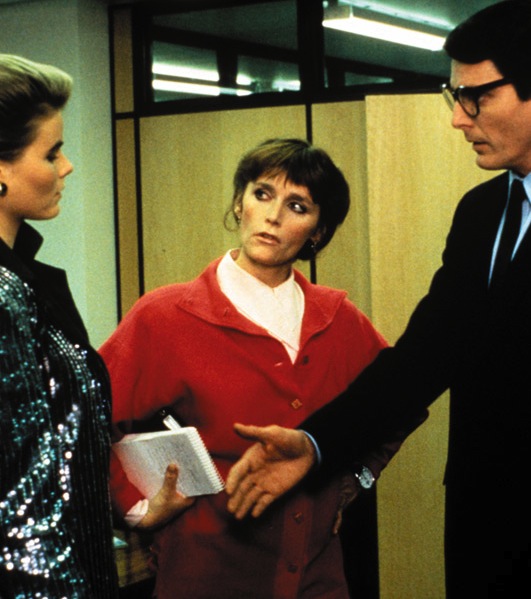Monday, July 27, 1987.
SUPERMAN IV: THE QUEST FOR PEACE. Written by Lawrence Konner and Mark Rosenthal. Story by Christopher Reeve, Konner and Rosenthal, based on characters created by Joe Schuster and Jerry Siegel. Music by John Williams, adapted and conducted by Alexander Courage. Directed by Sidney J. Furie. Running time: 88 minutes. General entertainment.
WHAT WAS IT COL. NORTH told us? "The world is a dangerous place."
Now that Ollie has some free time, he should take Betsy and the kids to see Superman IV: The Quest for Peace, a fantasy as straightforward, incomplete and intermittently entertaining as his testimony before U.S. Congressional investigators. In it, the Man of Steel (Christopher Reeve) confronts a situation that reflects "national hero'' North's own worldview.
It opens with an international crisis. The superpowers are on the brink of a nuclear confrontation. Somewhere in the Midwest, a concerned schoolteacher suggests that her pupils write to their Congressional Representatives of their fears.
Little Jeremy (Damien McLawhorn) has a better idea. Like Ollie, he hasn't a lot of faith in politicians or the political process. He sends his letter directly to Superman.
Like the lieutenant-colonel's world, the film business is a dangerous place. According to published reports, actor Reeve signed on for a fourth flight because "I really wanted Superman to confront some real, contemporary issues."
As sincere as his superhero alter ego, Reeve came up with "the idea of nuclear disarmament . . . telling the tale through the eyes of a 12-year-old schoolboy.''
Film producers Menahem Golan and Yoram Globus put him together with the screenwriting team of Lawrence Konner and Mark Rosenthal, the lads responsible for the 1985 Romancing the Stone sequel Jewel of the Nile.
In their film, Superman faces a major moral dilemma. Little Jeremy's letter urges him to action, but his other-worldly upbringing counsels non-interference in the affairs of men.
Echoing the advice given him by his father Jor-El (Marlon Brando) in the original 1978 Superman feature, the image of a Kryptonian elder (Trevor Howard) appears to tell him that "if you teach them to be dependent on any one man, you'll have betrayed them.'' Big Brother, no matter how benevolent, diminishes the human spirit.
In coming up with a storyline, the scriptwriters faced their own dilemma. Is it possible to deal with "real" political issues in a fantasy world populated by superbeings?
Their response, as far as can be judged from the film on view, was to allow Reeve the occasional high-minded speech in the midst of an unashamed comic-book plot. For conflict, we have the ever-reliable Lex Luthor (Gene Hackman).
Sprung from prison by his obnoxious nephew Lenny (Jon Cryer), "the Dutch Elm disease of the family tree,'' the entrepreneurial criminal genius offers his services to a consortium of international arms merchants.
When Superman declares "no more nukes,'' Luthor creates Nuclear Man (Mark Pillow), a supervillain dedicated to destruction. Their differences are settled in a climactic, globe-girdling superbrawl.
Adding leavening to the mix is a subplot involving the sale of the Daily Planet to tabloid tycoon David Warfield (Sam Wanamaker). Of course, his daughter Lacy (Mariel Hemingway) becomes infatuated with straight-arrow reporter Clark Kent.
When Lacy and Lois Lane (Margot Kidder) double-date with Clark/Superman, the scene is played as pure farce.
Directed by Sidney (Ipcress File) Furie, the picture is said to have come in at about two hours. Preview audiences were unkind to the result and, after re-editing, the release version runs only 88 minutes.
Despite Reeve's own good intentions, the final cut solves neither the moral nor the dramatic problems posed. What remains is a capably crafted comic book in which some thoroughly professional performers are undercut by less-than-perfect special effects.
Sadly, the best that Superman IV: The Quest for Peace can offer is a collection of fragmentary, if quite lovely, moments.
The above is a restored version of a Province review by Michael Walsh originally published in 1987. For additional information on this archived material, please visit my FAQ.
Afterword: The last (and least) of the original Superman franchise features, The Quest for Peace was a mid-career disappointment from Sidney J. Furie. The Toronto-bom director proved himself to be a capable craftsman for some 30 years before taking on the comic-book feature. He survived to make many more movies, the most recent one, a 2014 comedy called Pride of Lions, reunited him with Margot Kidder. At this late date, it's hardly a spoiler to reveal that Superman finally defeated the nasty, Nordic-looking Nuclear Man by causing a solar eclipse, which deprived the villain of his power source. Eclipses have fascinated filmmakers from the very beginning — pioneer cinematographer George Melies's 12-minute L'éclipse du soleil en pleine lune was made in 1907 — and they've shown up with great regularity in everything from Biblical to science-fiction features ever since. My own all-time favourite is the timely eclipse that occurs in the closing minutes of director Richard Donner's 1985 fantasy Ladyhawke, a moment of darkness that allows medieval lovers Isabeau (Michelle Pfeiffer) and Etienne (Rutger Hauer) to break the curse that separated them. The huge list of films that have blocked the sun to memorable effect include: Mel Gibson's Apocalypto (2006), a Maya-language tale of empire and human sacrifice in pre-Columbian Central America; Taylor Hackford's adaptation of Stephen King's Dolores Claiborne (1994), that involved the actual January 1963 solar eclipse; Oliver Stone's The Doors (1982), in which an eclipse is used to symbolize rock star Jim Morrison's spiritual quest; and George Lucas's Star Wars 3: Revenge of the Sith (2005), that uses an eclipse as a portent for Anakin's turn to the Dark Side just prior to his epic light sabre battle with Obi-Wan.
See also: The Man of Steel's first flight as a feature film star was in Richard Donner's Superman, the Movie (1978); followed by two Richard Lester-directed sequels, 1981's Superman II and Superman III (1983).
